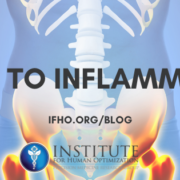METABOLIC ENDOTOXEMIA
Metabolic endotoxemia is a condition that affects many people in America. In fact, recent studies estimate that over one-third of adults in the United States have this health issue. It’s been estimated that it may soon be indirectly a leading cause of death. Follow us on this week’s blog to learn what it is and how to prevent metabolic endotoxemia.
Metabolic Endotoxemia
Metabolic endotoxemia is the presence of too much LPS (lipopolysaccharides) in the blood. LPS are toxins that reside on the outer membrane of bacteria that would otherwise not be allowed into our bloodstream. The American Diabetes Association identified bacterial lipopolysaccharide (LPS) as the inflammatory factor causative of the onset of insulin resistance, obesity, and diabetes. LPS triggers a cascade of immune responses. For example, after binding to its receptor TLR4 (TLR4 is a receptor found on the surface of cells that can detect LPS) or CD 14, there is an elevated level of tumor necrosis factor-alpha (TNFα). TNFα is a protein signaling molecule that is an inflammatory mediator that triggers the innate immune response. The innate immune system, as its name implies, is a primitive type of immunity that all living organisms have. In contrast to the adaptive immune system (which is found in humans and other higher-order species), there are no actual distinguishing features between cells belonging to the innate system or adaptive immune system – they simply look different. TNFα activates more TLR4 which results in more TNFα. As you can see, it becomes a vicious cycle leading to chronic inflammation.
LPS also induces cytokine production by activating inflammatory transcription factors known as nuclear factor kappa B (NF-κB). NF-κB is a protein complex that controls the expression of genes involved in immunity and inflammation. Inducing cytokine production helps our bodies fight off infections. However, it also activates the immune response to clear away cells that are injured or damaged by short-term inflammation. If this clearing of dead cells occurs chronically, it can lead to tissue damage and autoimmune diseases where the body starts attacking its own healthy tissues.
DIET & METABOLIC ENDOTOXEMIA
Paracelsus, a Renaissance physician said: “All things are poison; everything is poisonous; there is nothing without poisonous qualities. Only the dose permits something not to be poisonous.”
The severity of this disorder depends on how much LPS enters circulation and how sensitive an individual’s body is to these inflammatory agents. As expected, diet and lifestyle are critical when it comes to metabolic endotoxemia and other diseases.
Inflammatory transcription factors are also activated in response to a high-fat diet rich in saturated fats and low in fruits and vegetables. Inflammatory transcription factors are transcription factors that contribute to the initiation, regulation, and mediation of inflammation.
Saturated fatty acids trigger macrophages to create a cascade of inflammatory signals. Saturated fats refer to a type of dietary fat with no double bonds between the carbon atoms. They are typically solid at room temperature and found in foods such as beef, pork, poultry, butterfat (in dairy products), palm kernel oil, lard (in meat products), and cocoa butter. Inflammatory foods have been linked to causing an inflammatory immune response that results in endotoxemia, which is the presence of bacterial endotoxin (LPS) in the bloodstream.
METABOLIC ENDOTOXEMIA AND DISEASE
The relationship between metabolic endotoxemia and the onset of diabetes, obesity, and heart disease is well established. Metabolic endotoxemia causes the body to have increased cortisol levels. This causes increased insulin resistance, which can contribute to type 2 diabetes. Metabolic endotoxemia causes the body to have increased cortisol levels. This causes increased insulin resistance, which can contribute to type 2 diabetes. In a healthy body, insulin resistance may be caused by high cortisol levels in response to stress. This insulin resistance is typically temporary as a protective mechanism for the body, but in most people who are insulin resistant, a high carbohydrate diet makes them even more insulin resistant. So, these individuals will typically crave carbohydrates when their blood sugar is low from the stress cortisol is causing on their bodies with elevated insulin resistance.
Metabolic endotoxemia causes an increase in persistent free radicals, which contributes to chronic inflammation and aging of the cells. An increase in persistent free radicals is not optimal as this can result in the accelerated development of chronic disease. Chronic inflammation is cause for concern because it is associated with elevated risks of cardiovascular disease, Alzheimer’s disease, cancer, and many other chronic diseases. Metabolic endotoxemia also causes oxidative stress. Oxidative stress refers to the process whereby free radicals in cells cause damage to molecules leading to tissue and organ dysfunction. The human body has both antioxidant and anti-inflammatory mechanisms in place that operate in a feedback loop, such as red blood cells, white blood cells, vitamins C and E, uric acid, nitric oxide synthase (NOS), and more. This feedback loop works by protecting the cells from oxidative damage and removing damaged cells. However, there are many variables that can break the loop using mechanisms called hormesis. Hormesis refers to acute stress that leads to a beneficial effect. For example, exercise causes the body to emit oxidizing free radicals because it requires large amounts of ATP (energy) for muscle contraction. Metabolic endotoxemia however is not a beneficial mechanism. It is the result of an overload of free fatty acids (FFAs), cytokines, and NOS-derived NO which cause circulating endotoxins to disrupt the host’s metabolism.
Additionally, oxidative stress decreases cellular DNA repair. Cellular DNA repair is critical to our overall health and well-being. As we have discussed in recent blogs, DNA repair is critical for maintaining metabolic homeostasis. Failure to maintain metabolic homeostasis due to DNA damage from oxidative stress can lead to obesity, insulin resistance, and even type 2 diabetes.
In addition to causing insulin resistance and oxidative stress, metabolic endotoxemia has been linked to dysfunction of the hypothalamic-pituitary-adrenal axis. Our HPA Axis is critical for maintaining metabolic homeostasis. Our HPA Axis is responsible for the release of cortisol, our main stress hormone. We often think of the HPA Axis as being involved in stress but it involves every organ system in the body and is critical for maintaining normal body functions, including inflammation. Recent studies have established that in vivo administration of bacterial lipopolysaccharide (LPS) enhances hypothalamic-pituitary-adrenal (HPA) axis function by a mechanism involving endotoxin-stimulated cytokine release.
IMPORTANCE OF DECREASING INFLAMMATORY ALLOSTATIC LOAD
Deceasing our allostatic load is a component of reaching our optimal health. Allostatic load refers to the wear and tear on the body through stress. Metabolic endotoxemia contributes to the reduction in our allostatic load. Meeting one’s optimal health includes having a healthy weight, healthy blood sugar levels, and low inflammation among many things. The decreasing allostatic load can be done by increasing physical activity and mindfulness, improving nutrition, reducing stress, maintaining social connections, and getting enough sleep. Decreasing the number of factors involved in the allostatic load will help decrease the overall inflammatory response.
Don’t know where to start? At the Institute for Human Optimization, we will work with you directly to optimize your well-being. No two patients are the same, so we work with you and create a personalized and individual approach to your health concerns. Contact us today to get started.
____________________________________________________
References
https://www.ncbi.nlm.nih.gov/pmc/articles/PMC4695328/
https://diabetes.diabetesjournals.org/content/56/7/1761













Leave a Reply
Want to join the discussion?Feel free to contribute!